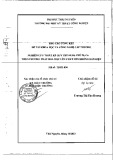
Targeting of malate synthase 1 to the peroxisomes of
Saccharomyces
cerevisiae
cells depends on growth on oleic acid medium
Markus Kunze
1
, Friedrich Kragler
1,
*, Maximilian Binder
2
, Andreas Hartig
1
and Aner Gurvitz
1
1
Institut fu
Èr Biochemie und Molekulare Zellbiologie der Universita
Èt Wien and Ludwig Boltzmann-Forschungsstelle fu
Èr Biochemie,
Vienna Biocenter, Austria;
2
Institut fu
Èr Tumorbiologie-Krebsforschung der Universita
Èt Wien, Vienna, Austria
The eukaryotic glyoxylate cycle has been previously
hypothesized to occur in the peroxisomal compartment,
whichintheyeastSaccharomyces cerevisiae additionally
representsthesolesiteforfattyacidb-oxidation. The sub-
cellular location of the key glyoxylate-cycle enzyme malate
synthase 1 (Mls1p), an SKL-terminated protein, was
examined in yeast cells grown on dierent carbon sources.
Immunoelectron microscopy in combination with cell frac-
tionation showed that Mls1p was abundant in the peroxi-
somes of cells grown on oleic acid, whereas in ethanol-grown
cells Mls1p was primarily cytosolic. This was reinforced
using a green ¯uorescent protein (GFP)±Mls1p reporter,
which entered peroxisomes solely in cells grown under oleic
acid-medium conditions. Although growth of cells devoid of
Mls1p on ethanol or acetate could be fully restored using a
cytosolic Mls1p devoid of SKL, this construct could only
partially alleviate the requirement for native Mls1p in cells
grown on oleic acid. The combined results indicated that
Mls1p remained in the cytosol of cells grown on ethanol, and
that targeting of Mls1p to the peroxisomes was advanta-
geous to cells grown on oleic acid as a sole carbon source.
Keywords:Saccharomyces cerevisiae; glyoxylate cycle;
peroxisome; malate synthase 1; oleic acid.
Microorganisms are able to grow on nonfermentable
carbon sources such as acetate, ethanol, or fatty acids,
because they possess a glyoxylate cycle for generating four-
carbon units that are suitable for biosyntheses of macro-
molecules. Similarly, plant seedlings can also use stored
lipids as a sole carbon and energy source, by converting the
acetyl-CoA product of fatty acid b-oxidation to four-carbon
units using a cognate process. In those eukaryotes known to
possess a glyoxylate cycle, e.g. plant seedlings and fungi, the
process is thought to occur in the peroxisomal matrix.
Peroxisomes typically contain enzymes for reactions
involving molecular oxygen and for metabolizing hydrogen
peroxide [1]. This subcellular compartment represents the
site of fatty acid b-oxidation, which in mammals is
augmented by an additional process found in the mito-
chondria [2]. The signi®cance of the fungal glyoxylate cycle
to human health is underscored by the requirement of
isocitrate lyase for the virulence of the pathogenic yeast
Candida albicans [3]. Like the situation with C. albicans,
Saccharomyces cerevisiae cells isolated from phagolyso-
somes obtained from infected mammalian cells similarly
up-regulate isocitrate lyase as well as malate synthase, both
of which represent key enzymes unique to the glyoxylate
cycle [3]. As S. cerevisiae is a genetically more tractable yeast
than C. albicans, it was chosen as a model fungal system for
studying the glyoxylate cycle by analysing the subcellular
distribution of malate synthase 1.
The S. cerevisiae glyoxylate cycle (Scheme 1) consists of
®ve enzymatic activities, some of which are represented by
isoenzymes: isocitrate lyase, Icl1p [4]; malate synthase,
Mls1p and Dal7p [5]; malate dehydrogenase, Mdh1p [6],
Mdh2p [7] and Mdh3p [8,9]; citrate synthase, Cit1p [10],
Cit2p [11,12] and Cit3p/YPR001w [13]; and aconitase,
Aco1p [14] and Aco2p/YJL200c [13]. As mentioned above,
isocitrate lyase and malate synthase represent key enzyme
activities that are unique to the glyoxylate cycle, whereas
some of the remaining enzymes, e.g. mitochondrial Cit1p,
Mdh1p, and Aco1p, are shared with the citric acid cycle.
Icl1p is an extraperoxisomal protein, while Mdh3p and
Cit2p are peroxisomal ones. The latter two enzymes end
with a C-terminal SKL tripeptide representing a peroxiso-
mal targeting signal PTS1 [15±17].
The two malate synthases Mls1p and Dal7p are also SKL-
terminating proteins that are 81% identical to one another.
However, as the MLS1 gene is highly transcribed on
nonfermentable carbon sources and is essential for cell
growth on these media, whereas DAL7 is not [5], it is
reasoned that only Mls1p represents the malate synthase
activity speci®cally involved in the glyoxylate cycle. Dal7p,
whose peroxisomal location remains putative, is actually
thought to be involved in the metabolism of glyoxylate
produced during the degradation of allantoic acid to urea [5].
Initial work on peroxisomal citrate synthase (Cit2p) led to
the conclusion that the glyoxylate cycle is a peroxisomal
process [12]. However, the cycle's subcellular location is no
longer clear because peroxisomal Cit2p has since been
shown to be dispensable for the glyoxylate cycle [9] and,
moreover, cells lacking peroxisomal malate dehydrogenase
Correspondence to A. Hartig, Institut fu
Èr Biochemie und Molekulare
Zellbiologie, Vienna Biocenter, Dr Bohrgasse 9, A-1030 Vienna,
Austria. Fax: + 43 1 4277 9528, Tel.: + 43 1 4277 52817,
E-mail: AH@abc.univie.ac.at
Abbreviations: PTS1, peroxisomal targeting signal type 1; YP, yeast
extract/peptone; GFP, green ¯uorescent protein; Mls1p, malate
synthase 1; Cit2p, peroxisomal citrate synthase.
*Present address: Section of Plant Biology, Division of Biological
Sciences, University of California, One Shields Avenue, Davis, CA
95616, USA.
(Received 2 August 2001, revised 3 December 2001, accepted 5
December 2001)
Eur. J. Biochem. 269, 915±922 (2002) ÓFEBS 2002






























